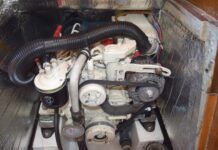At boat shows, you see clipper-bowed boats with wooden spars cheek by jowl with IOR racers with reverse transoms and straight sheerlines. Each may be attractive in its own way. Both can also be little more than caricatures.
Although “style” may sound like a question of pure aesthetics, style is also a matter of function. A reverse transom on an IOR boat is there purely for rating reasons. For the owner or potential buyer of the cruiser/racer modeled in some fashion after an IOR racer, a reverse transom may be a reminder of a racing heritage. Maybe it just looks fast. Of course, the first time your cruiser/racer takes a following sea up that nice sloping transom, your ideas about style may change radically.
At the other end of the scale is the pure cruiser. You can recognize it by a lot of beam, a lot of freeboard, a smallish rig – perhaps with untapered, varnished wooden spars – and perhaps such classic features as a taffrail with turned wooden stanchions, or fake planking seams scribed into the fiberglass topsides.
The owner of a wooden yacht will shudder at the scribed-in seams, since he just spent the better part of two weeks sanding, puttying, and painting to make those all-too-visible seams disappear. So will the craftsman who spent hours carefully fitting each plank so that only the tiniest of caulking seams – or no seam at all – marred the topsides of the goldplater he built so long ago.
The experienced ocean cruiser will. look at the stubby rig and think of days in the doldrums, burning precious fuel to look for wandering catspaws. He or she may also look at the acres of varnish and shudder at the prospect of keeping it on the wood in searing tropical sunshine or driving salt spray.
Even the least experienced owner may look askance at turned wooden stanchions after the first time he tries to apply five coats of varnish.
Those bronze cleats, winches, and portlights may look good on your modern cruiser, but what price are you paying in excess weight? At the same time, will those aluminum cleats survive a few years exposure in the tropics, or will they turn to a pile of oxidation? And wouldn’t your cruiser/racer look just as good with modern hardware, instead of pseudo-traditional gear?
An appreciation of style may come only with years of experience. Familiarity with the history of design may reveal both strengths and weakness of the old-fashioned ways to do things. Modern materials and methods may save time and money – or they may disintegrate under the test of time.
The more you look at things, the more you will see the merging of style and substance. Style without substance is anathema to the mind of the seaman. But substance without style will never steal his heart. You shouldn’t have one without the other.


































